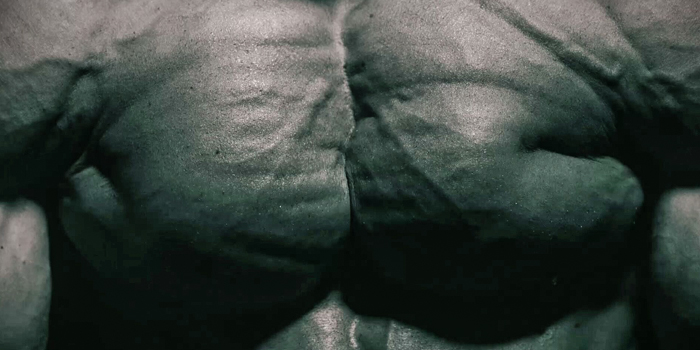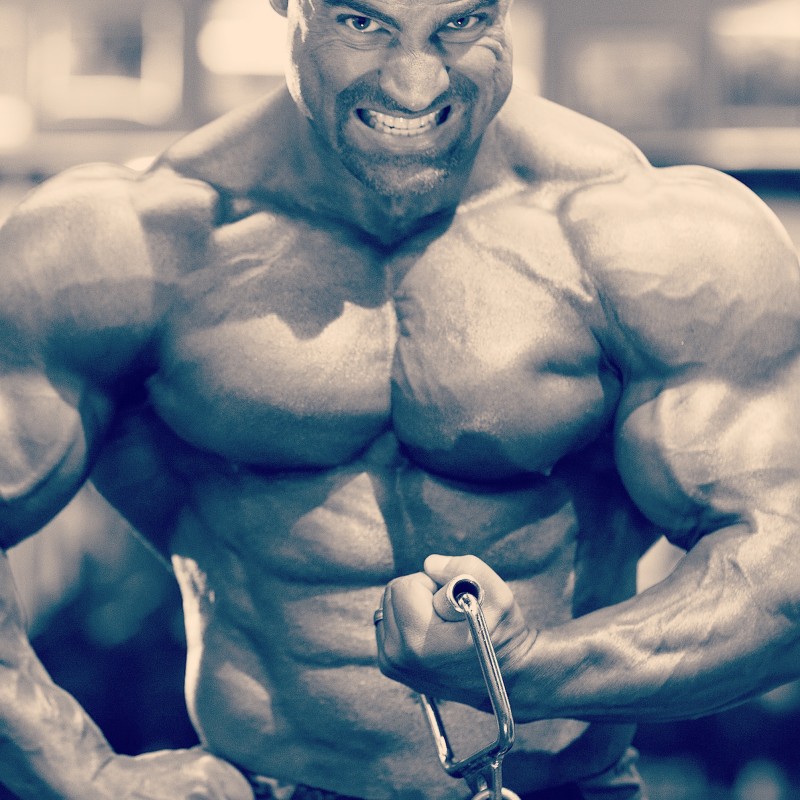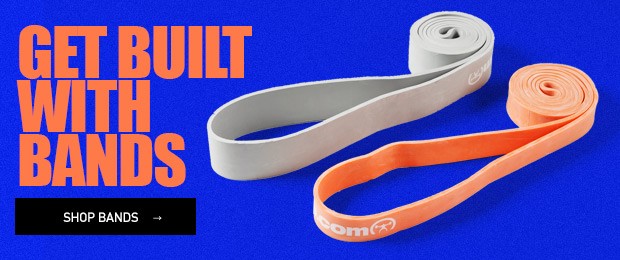
In 2006 while entering my second year of competing in the IFBB Pro League, and within a week of filming my first DVD, Driven, I felt what can only be described as a zipper-like sensation in my right quad. It was on my 12th rep of leg press with about 12 plates per side. I never forgot that zipper-like feeling associated with a muscle tearing, and didn’t experience it again to a significant degree until 2010.
What is it about guys that makes us want to see how much weight we can move?
I learned my lesson the hard way on that fateful night at Kirkland Gold’s Gym some seven years ago. Warming up on bench press, I cruised through 405 pounds, though the eccentric portion left me saying, “My pecs feel tighter than normal.” By the time I loaded 500 pounds on the bar, my mind was set – never mind the fact I compete in bodybuilding and how you look on stage matters infinitely more than how much you bench press.
RELATED: Back to Recovery Basics: Fundamentals of Recovery
Rep one went up okay, so my training partner demanded: “One more!” The fleeting thought of damn my pecs felt tight on the eccentric phase of my first rep quickly vanished on rep two, as I felt that pronounced zipper-like sensation lowering the weight. My training partner helped me get the weight up and excitedly exclaimed, “Nice work!” But I laid there on the bench nervously responding with, “Shit! I think I just tore my pec.” I headed for the bathroom trembling at what I might find upon removing my shirt.
Standing shirtless in the men’s locker room, the damage was hardly noticeable. There was no discoloration but there was some slight swelling. It felt like someone punched me extremely hard in the left pec. Back in the weight room I tried something light and knew the workout was over. Thankfully, the tear did not include full pec tendon detachment and no surgery was required. The following details my recovery approach.
Hindsight is 20/20 — the preponderance of pec tears comes on barbell bench press.
Recovery Therapies
Undecided on the best course of action, I went home and iced my pec to minimize the swelling and applied the topical ointment Traumeel. I awoke the next morning to limited mobility due to tightness in the pec, but gratefully little to no discoloration, which I assumed indicated the telltale sign of something more serious. I went to see Dr. Neno Pribic, my chiropractic and active release technique (ART) specialist who has helped a number of Seahawks recover from pec tears. He confirmed that I experienced a partial tear to the muscle belly near the attachment to the pec tendon.
Neno went on to explain the initial goal is to expedite healing and minimize scar tissue. Minimizing scar tissue during my visit meant applying ART to my torn pec. To say it hurt would be a gross understatement, as he proceeded to dig his thumb into my pec while moving it through a full range of motion before sending me off to ultrasound therapy.
Ultrasound therapy is used to transmit ultrasonic waves through soft tissue, ligaments, and tendons to heat the area and increase blood flow. Getting fresh blood to the injury as well as removal of old blood is key to healing. I began cupping and acupuncture for these reasons as well.
Sound assist soft tissue mobilization (SASTM) is another available technique for breaking up scar tissue, which I highly recommend. It is similar to the Graston Technique in identifying and resolving lesions and other fascial restrictions. Unfortunately, I was unaware of SASTM at the time, but began using this therapy in the past year. I wrote an article about my experience here.
Return to Training
Recovery took a good eight months before I could train without feeling like my pec might tear again. In terms of training progression, I started simply with resistance bands. Attaching one end around a cage upright, I would press out and hold the contraction with one arm at a time. Full range of motion movement is good so long as you don't overdue the weight. Initially, a bodyweight push-up felt dangerous.
You can progress up in banded tension via these suggestions:
I eventually progressed to push-ups and very light weight machines. I now rarely ever feel anything “off” when pressing with 100% intensity, but I also train much differently. There’s wisdom in avoiding exercises that don't over stretch the pec tendon insertion, increasing muscle tension through bar instability, and/or deloading weight at the transition from eccentric to concentric.
Suggestions include the use of an elitefts Shoulder Saver Pad, or stick with floor presses, hanging band technique (HBT) presses, or reverse banded incline presses rather than conventional barbell bench press. The videos below show these examples:
Floor Press
HBT Press
Reverse Banded Incline Press
My desire for you is simply that you never experience a pec tear. Learn from my error and implement strategies to minimize the risk of serious injury with the previously referenced exercises. If ever confronted by that evil zipper-like sensation, I hope the recovery methods I shared will put you on the fast track to full training. Train hard. Train smart!












Thanks for the positive feedback on the article and sorry to hear about your pec ruptures. However, glad to know you are still training!
Be safe,
Mark
So sorry to hear about your biceps, but it sounds like you are on the right track towards recovery.
All the best,
Mark
I can relate to what you're feeling from when mine tore, although I stopped caring about impressing other guys in the gym with how much I bench press a long time ago. I would rather be muscular and in shape than have a massive bench press. I very rarely bench press 315 anymore, but I've found other ways to challenge my pecs that are safer.
Sorry to hear about your injury. Hope you experience a speedy recovery!
All the best,
Mark
Do you intend to compete in powerlifting? If so, then using the shoulder saver 100% of the time might not be best. Keep in mind this comes from a guy who doesn't compete for numbers. If you don't compete and want to avoid injury I don't see why the saver pad exclusively would be detrimental.
Hope this helps!
Mark
Less than a year ago, I had a complete Pec. Major ligament tear at the myotendinous junction. I was able to immediately see my future surgeon the next day, however, still several weeks until surgery. He had previously been the team surgeon for the Houston Texans, but his words showed me the magnitude and rarity of a tear at the junction.
I asked how sure he felt about this surgery and what the likely hood of me being able to ever use my arm again at half the capacity. He replied, "Well, I believe there's an 80% chance that I will walk away from the surgery feeling that I did the best that I could. And there's about a 60/40% chance over the next 5 years that you will have healing that will allow you to use it at half-capacity."
Long story short, at 6 weeks I was 12 weeks ahead of schedule and glory be to Yahweh that I have complete ROM and no additional restrictions.
I concur with the above suggestions and methodologies. Pt. 1 - Swallow your pride and if you feel like you need to take it slower, work slower. Pt. 2 - If you've been in the lifting or strength world for awhile, no one knows your body better than you so listen to it and advance to lightweight, minimal reps at the beginning and then increase the volume (Not Weight).
All the best,
Mark
So sorry to hear about your pec tear. I really don't notice mine that much anymore. I don't lift as heavy as I once did either. Mine was a tear of mostly the muscle belly and therefore I was told that there wasn't anything they could do surgically to "repair" it. My understanding is that unless the tendon completely tears or the muscle detaches to a significant degree there isn't much to be done.
My best advice based on me own experience is to train lighter, smarter and work to maintain your mobility.
I hope this helps.
Mark
That zipper like sound pain is so accurate and unfortunately happened to me yesterday whilst doing some DB presses.
Had an ultrasound today and: "There is an avulsion of the sternal fibres of the pectoralis major muscle at the humeral attachment"
Seeing a specialist tomorrow. Feels like just really bad doms no discolouration or anything too hectic yet from the scans and all that seems like they are wanting me to have surgery ASAP. Sucks so much.
Thank you for sharing your experience with us.
The worst part for me is how will I train and try maintain/gain some size (don't mind if I don't do chest ever again) but feel like with this issue I am going to be limited with everything else now...
Going to be an interesting road ahead :(
Sorry to hear of your injury, but you will get through this. Life is a series of obstacles. We simply have to find ways to work around and through them.
All the best,
Mark
This is the first set of information I have found that is making me feel even the slightest bit better about this injury. I had the same exact injury as you described here about a week ago, also on my left side...and also no surgery for the same reason (tear at muscle/tendon junction). I like the recovery techniques you have outlined here and will surely use this moving forward. Thanks for providing a ray of light on this sucky injury pal. Much love.
Sorry to hear about your injury. There is a path forward and light at the end of the tunnel.
All the best!
Mark
I honestly didn't look into surgery because I knew my pec wasn't completely detached and I was a month out from a competition. My ART therapist who worked with professional athletes didn't think the ROI on surgery was worthwhile. I will add that I cared more about cosmetic appearances from a bodybuilding stage than strength, so I may be the wrong person to ask.
I hope this helps and sorry to hear about your injury.
All the best,
Mark
Sorry to hear about your two tears. Glad the most recent wasn't too serious. You probably need to assess the exercises and weight you are lifting to determine which is contributing to your injuries. Also, assess your form and rep tempo as they may also be contributing factors. I recently bought a tool from SASTM - sound assist soft tissue mobilization.
It would be a great tool in addition to ART to break down scar tissue.
Definitely go back to training slow. Control the transition from the eccentric to concentric, and possibly shorten the range of motion to reduce tendon stress.
I hope this helps.
Train smart!
Mark
All the best,
Mark
So sorry to hear about your injury. I got about 70% of my strength back, but keep in mind I was never really training for strength as a bodybuilder. That's not to say I wasn't still a meathead because mine tore on my second rep with 500lbs - a pointless attempt for a bodybuilder.
I wanted to extend my bodybuilding career so I rarely went over 315lbs after the tear. My pec feels as strong as before the tear at this point, but I don't push the limits anymore either.
All the best in your recovery!
Mark
Jeff...
Get surgery, it's always an option for a complete tear, or even if it is part/all muscle. If your doctor won't do it, go see another doctor.
They can do muscle to muscle surgery with a graft (allograft/cadaver tendon).
It’s Good to hear your story. Do you know how much of the muscle tore?
I experienced a partial tear - about half- of the tendon at the bone half a year ago. I fell onto the shoulder weirdly and bust my ACJ then dropped slightly further to get most of the posterior laminar of the pec tendon. A pretty shitty way to do it IMO. I lift recreationally but I value strength and love maxing out. I also know that tendons are strong as shit and that it might not make so much of a difference in the long term. I am a lifetime natural which I think might be beneficial to lessen the risk of a re rupture under a heavy load, that said, my best bench was 175kgs with a pause, and I am aware that there are inherent risks with that weight, risks which go up if you have a smaller tendon.
Even before the injury, I had come to think that the floor press is a better option for me as my chest is big enough to rest the bar on on the ground, my best lift in this being 167.5kgs. I never bench with a wide grip.
I’m due to see a shoulder surgeon to discuss whether it is worth repairing the chronic tear or not. I would take a small loss in strength as I know that other muscles will strengthen to compensate for a weakness over time but I am concerned that such a significant tear would produce an unacceptable loss n long term strength.
What would you say I should do?
Regards,
Joe